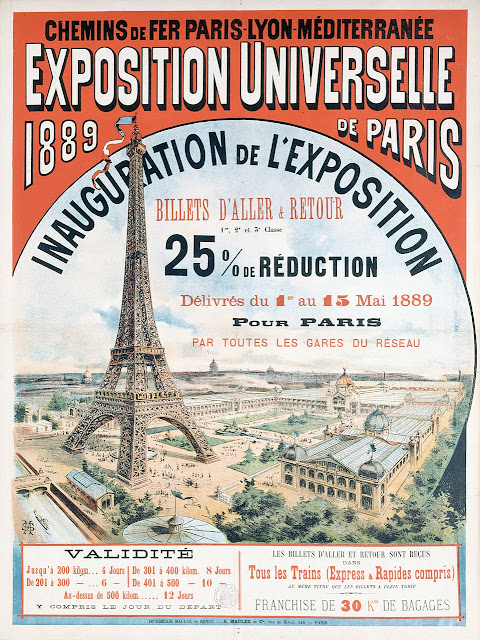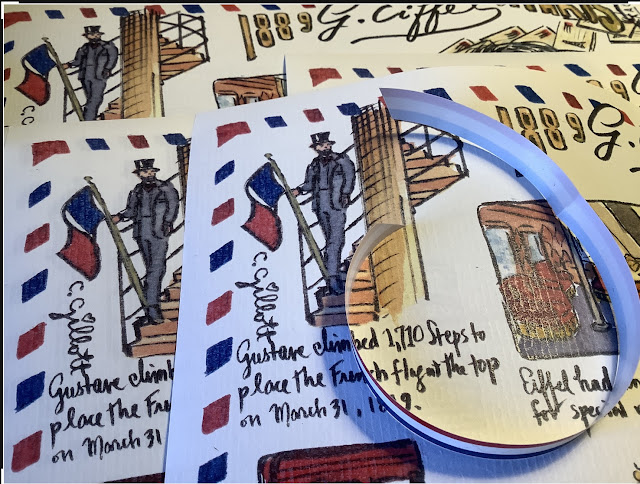One thing is certain. He was a bridge person. He built hundreds of bridges the world over (who knew?) mainly railroad bridges like the Garabit Viaduct,
Jill Jonnes, author of Eiffel’s Tower refers to the Tower as “a vertical bridge”. It makes perfect sense in this context. I never saw this until I knew more of Eiffel’s life-long obsession.
Can you draw ✏️ a map of a thing or a person? Why not. I did😊
This ‘map’ is a compilation of some little-known facts about the tower and Eiffel.
Focusing on the time of the 1889 Exposition Universelle.
Initially there were tremendous fights against the tower’s creation. Champs des Mars residents threatened to sue (their property values would go down - the opposite happened). A protest letter from Paris’ 300 most influential writers, musicians and artists like Guy de Maupassent, Charles Gounod, Charles Garnier. Endless Insults were hurled; “A dizzyingly, ridiculous tower dominating Paris.", “This high and skinny pyramid of iron ladders, this giant, ungainly skeleton.” My favorite,”This truly tragic street lamp.”
As the tower took form, dissenters changed their tune and were in awe of its immense beauty.
At the opening there were 4 restaurants on the first floor serving Russian, French, Flamand and Dutch cuisine to 500 guests each.
De Maupassant ate there daily, claiming it was the only place in Paris he couldn’t see the monstrosity.
Did you know Eiffel was assisted by his eldest daughter, Claire for some 40 years. She married his top engineer and they eventually took over Eiffel’s construction company.
So many fascinating tales to the Eiffel Tower’s history. Did you know the tower had a 20 year contract and was to be torn down in 1909 and sold for scrap? Eiffel set to work prodigiously making the tower a practical necessity for multi scientific purposes - for weather prediction, use in radiography, as a beacon and later during the war for signaling. Today it serves as a radio and TV transmitter as well. The new Gustave Eiffel ‘map’ is on Etsy. If you are a letter subscriber, your Eiffel map 💌is in la poste📮 Bonne Weekend PBers❤️😊🐻





































Your Eiffel is amazing! ❤️ So detailed,
ReplyDeleteIn Baja Mexico, there was a French Mining community and Gustaf Eiffel designed a church which was built there for the French families.
ReplyDeleteFascinating, I knew a few of those facts but now I know so much more. It's amazing how something that was not supposed to last has become an iconic symbol of Paris.
ReplyDeleteEven though the most tourist attraction I LOVE IT!. Have been there so many times but yet Carol you have revealed so much that I did not know. I love your research & all the work that you do behind the scenes🗼❤️
ReplyDeleteI read about him researching my mysteries. He was a true genius. He was working with wind tunnels at the end of his life.
ReplyDeleteWonderful map, Carol! I can’t get enough of the Eiffel Tower. It is an amazing piece of architecture and beautiful to boot. Lots to learn from your map. ❤️
ReplyDeleteAll that, and it SPARKLES! What a lovely sight!
ReplyDeleteYou are amazing….. this is so wonderful!!!
ReplyDeleteIsn’t it amazing that people were so opinionated about what is such an iconic part of Paris!? Never ceases to amaze me how critical people are. Wonderful stories here.
ReplyDeleteBut many reacted the same way to Christo’s l’Arc de Triomphe
ReplyDeleteI love it when you get obsessed. I learn so much.
ReplyDeleteI have only been to the top once. The second level twice. Elevators have to be working.
Take care
And I have been to the 1st floor onc time 🤔
ReplyDeleteMust change that
Hi Carol, Thanks for the photos and illustrations from the 1880s! Also enjoyed reading the back story. I was very surprised that the idaea and designs for the tower weren't Messr. Eiffel's. From your link to Bertrand Lemoine's articles, it was the Eiffel Co.'s engineers, Messrs. Nouguier and Koechlin - and later his architect Messr. Sauvestre. Nothing like hiring the right people!! Although, it was Eiffel's business skills that made it possible, and forever cemented his name into Parisian history. Interesting how that works … — Lydia
ReplyDeleteCorrection Lydia.
ReplyDeleteThe tower was Eiffel’s idea and he submitted it to the Exposition committee for the competition along with 70 other ideas. Eiffel fought for it prodigiously and paid entirely out of his pocket for its construction. He also reaped the enormous financial benefits.
The 2 men who actually designed and did the grunt work were part of his engineering team. Originally they owned the copyright, but Eiffel bought it from them.
Bernard Lemoine is the expert on everything Eiffel and that website is a goldmine of information.
https://www.toureiffel.paris/
It should say Eiffel’s submission was chosen from out of 107 proposals submitted,
ReplyDeleteWhat if it hadn’t won!? Imagine that
Wow! You outdid yourself on this one! All this great info! I’m obsessed with the Eiffel Tower & all it’s history! This one is perfect to frame!
ReplyDeleteI LOVED this…and have pics of the Tower in my BR…the “Paris” room…;)…merci beaucoup!!
ReplyDeleteThank you Ch’An Etc. I didn’t know this obscure morsel..
ReplyDeleteAlexander Gustave Eiffel (of Eiffel Tower fame) had designed a pre-fabricated metal church in 1884 as a prototype for missionary churches in France's tropical colonies. Built in 1887 to be strong enough to withstand severe tropical weather, the church is made from galvanized iron. In 1889 the church and the Eiffel Tower were put on display at the Paris World's Exposition. Gustave won first prize for the church's design.
Years later, an official for the French Boleo Mining Company learned of the church being stored in a Brussels warehouse. He purchased it and had the church shipped to Santa Rosalía where it was reassembled in 1897. It was given the name 'Iglesia de Santa Bárbara'
What a super map and what a coincidence that lately I have been reading the Jonnes “Eiffels’ Tower” book. A very interesting history of the tower and all the hoopla surrounding it. Just read about the Wild West Show today - maybe a vignette of Annie Oakley on a future map….!
ReplyDeleteFrom: https://www.toureiffel.paris/en/the-monument/history
ReplyDelete"The wager was to "study the possibility of erecting an iron tower on the Champ-de-Mars with a square base, 125 metres across and 300 metres tall". Selected from among 107 projects, it was that of Gustave Eiffel, an entrepreneur, Maurice Koechlin and Emile Nouguier, both engineers, and Stephen Sauvestre, an architect, that was accepted."
"Emile Nouguier and Maurice Koechlin, the two chief engineers in Eiffel's company, had the idea for a very tall tower in June 1884. It was to be designed like a large pylon with four columns of lattice work girders, separated at the base and coming together at the top, and joined to each other by more metal girders at regular intervals."
"On September 18 1884 Eiffel registered a patent "for a new configuration allowing the construction of metal supports and pylons capable of exceeding a height of 300 metres".
"In order to make the project more acceptable to public opinion, Nouguier and Koechlin commissioned the architect Stephen Sauvestre to work on the project's appearance."
— Lydia
Love it! What a cast of characters!
ReplyDeleteCompliments! you on a tremendous piece of work — background, stories, map.
ReplyDeleteFantastic. I certainly didn’t know much about his background.
It was built in such a short time, truly considering it's size...that it had a restaurant to feed the workers....it's phenomenal the stories behind it!! Love this Carol!!! Thank you
ReplyDeleteThis is a fun and fascinating post. I love it when you tell us the history -- and the map is wonderful! Love all the drawings for it.
ReplyDelete